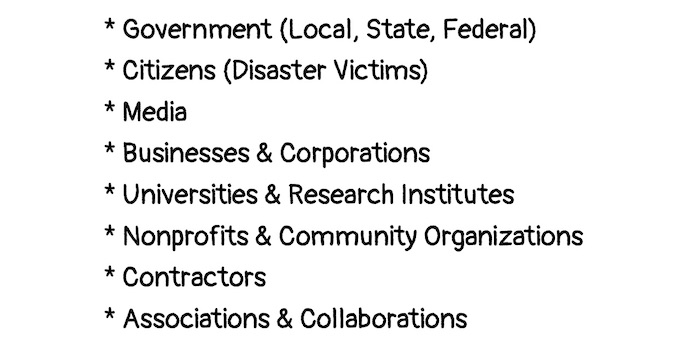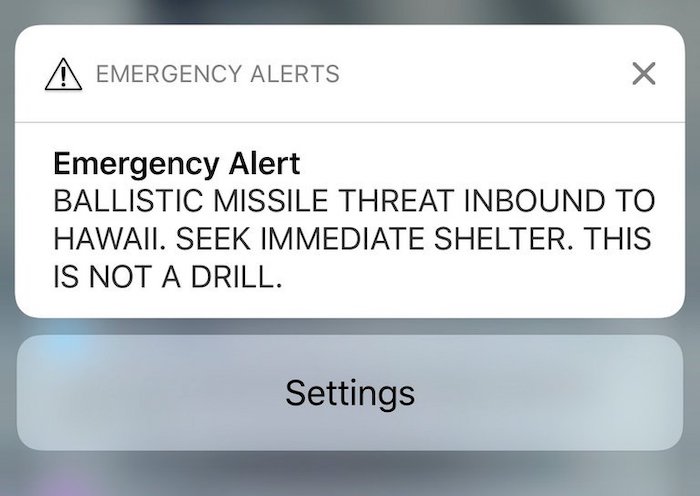This is a daughter-father collaboration. Peter Morville is a pioneer of information architecture and user experience. Claire Morville is a senior at the University of Maryland iSchool and works at the Crisis Technologies Innovation Lab.
We exist in a liminal era of crisis. In the whole of climate change, ecological collapse, mass extinction, cultural stress, political dysfunction, and infrastructure decay, the danger is greater than the sum of its parts. Shall we overcome? HIV/AIDS, 9/11, Katrina, Maria, unsafe tap water, raging wildfires, failing power grids: let’s just say we’re doing a “heckuva job.”
Yet, by definition, a crisis is a turning point. In times of transition, a small force can make a big impact. Technology plays a role. We must invent better solutions. But that’s not all. We must rethink our problems. To become sustainable, we must change beliefs and behavior. The medium that matters is culture. The lever that’s ready to hand is information architecture.
The structural design of shared information environments is mostly applied to websites and software, yet the application of information architecture to crisis management is promising. Clear organization, labeling, navigation, and search are vital to users in crisis. Good usability, findability, and user experience design for stress cases means life or death in crisis technology.
But that’s not all. In the mapping of language and classification systems, IA pivots from solution space to problem space. As Planning for Everything reveals, maps of words and categories help us to understand and think differently about the design of paths and goals.
We are bridge builders who brave the Tower of Babel’s confusion of tongues. We talk with stakeholders in disparate silos and users in diverse contexts. We sketch models of language, categories, systems, and relationships. We know How to Make Sense of Any Mess. In short, it’s hard to imagine a field more in need of information architecture than crisis management.
Crisis Management
Let’s start with the spectrum. Emergencies occur every day within a community. Police, firefighters, and paramedics respond to car accidents, house fires, and heart attacks. Emergency managers coordinate inter-agency operations. Emergencies are handled locally.
In contrast, disasters are rare and disruptive. A disaster overwhelms local capacity. Outside help is needed. A hurricane, wildfire, or flood may warrant in-state or interstate mutual aid or even a federal disaster declaration. Catastrophes, such as Hurricane Katrina, impact a region, render infrastructure inoperable, make it hard to help, and disrupt communities for years.
In managing all crisis types, taxonomy matters. In the Disaster Ecology taxonomy, for instance, the choice to split human-generated disasters by intent invites the study of differences between categories and the insight that psychological and social trauma are worse when disasters are intentional.
Or by sorting disasters into fast and slow categories, we might explore our ability to prevent or mitigate the worst impacts of drought, famine, and pollution. Classification governs action. Folks are more likely to evacuate if the hurricane is Category 5. Of course, scales can mislead. That’s why seismologists have upgraded from Richter to Moment. Sadly the media and general public still rely on the old scale. We shape our categories; thereafter they shape us.
The field of crisis management is organized by phase: mitigation, preparedness, response, recovery. These words and categories matter. They become jobs and departments. They forge identities and draw boundaries. People tasked with response may have insights for mitigation, but no authority. All maps are traps. So it’s good to foster cross-silo collaboration.
In crisis management, there are myriad stakeholders with whom to collaborate. Identifying all of them helps, as how we organize, prioritize, and mobilize stakeholders impacts the outcome. Mostly, government takes the lead, aided by NGOs, businesses, and contractors like Hagerty and IEM. The media matters since there’s nothing more vital in a crisis than communication.
In any list, it’s worthwhile to ask “who’s missing?” A disaster impacts the whole ecosystem. All sentient beings are stakeholders. If we neglect pets in plans, folks are less likely to evacuate. If we talk exclusively with executives, we may miss janitors who know building layouts. In 2005 FEMA said “libraries are not essential services,” and excluded them in the Katrina response. In 2010 libraries were reclassified, so they might better serve communities in times of crisis as safe spaces with trusted information. An open mind opens the door to better ideas and help.
Fred Rogers told us to look for the helpers. Crisis managers should take heed. To classify citizens as victims is a mistake. Contrary to urban myth, disasters bring out the best in people. In Katrina, the Cajun Navy rescued more than 10,000 people from flooded homes and rooftops. In Texas, Ryan Sivley rescued 500 people from icy roads. It’s important to encourage such heroic behavior. That’s why we have Good Samaritan law.
Disaster Improv
We know how to plan. Experience suggests the All Hazards approach since needs (e.g., communication, rescue, shelter) are shared across crisis types and phases. And we know how to communicate. Research suggests warnings and instructions must be specific and accurate, and folks are more likely to listen to a person who sounds like them and speaks their language.
It’s what we don’t know that gets us. Disasters wreck plans. That’s why improvisation is vital. To evacuate horses and cows in a wildfire at Gentle Barn, Ellie Laks flagged down trucks on the highway. To survive an explosion on Apollo 13, astronauts transformed the lunar module, meant to support 2 astronauts for 45 hours, into a lifeboat to support 3 astronauts for 3 days.
Fortunately, improvisation is a skill we can build. Individually, we can grow our internal locus of control to enhance our capacity to plan and improvise. Organizationally, we can defer responsibility and decision making to the lowest level, in small teams loosely joined, with coordination at the highest level necessary, to enable creativity and flexibility at scale.
Solution Space
On January 13, 2018, a ballistic missile alert for Hawaii was accidentally issued over radio, television, and telephone via the Emergency Alert System. Given no further information or instructions, residents and tourists panicked. It took 38 minutes to issue an official retraction.
While attention focused on human error, the root cause was bad design. The information architecture and user experience were so bad, it was easy to blunder even in the absence of crisis. Imagine scrambling to use this system amidst the chaos and terror of a real nuclear attack.
In a crisis, operating IQ drops by 15 percent or more. In fight or flight mode, we experience tunnel vision. With no time to plan, we act to understand, a form of sensemaking that can make things worse. This is why Don’t Make Me Think should be gospel for crisis technology.
In a sense, all tech is crisis tech. When Waze sent commuters towards California wildfires, due to light traffic in the disaster zone, its context of use became life or death. When Eric Meyer was racing across the country to be with his daughter who was in a medically-induced coma, his use of the hospital website was a stress case. Crisis adaptations include Facebook Safety Check, Twitter Alerts, and drones. Findability, accessibility, and usability matter, always.
But for crisis information technology, IA and UX matter even more. Design is mission critical for Disaster Tech, FirstNet, GoTenna, HOT, Intellistreets, One Concern, OurSafeQ, Ushahidi, and Zello. The stakes are high. The physical and cognitive burden on users must be low.
The usual practices of information architecture, user experience, and service design apply, but it’s also worth exploring crisis informatics, design principles, and research methods. People may be untruthful about behavior in a disaster, and simulation has limits, so there’s no substitute for ethnography. Ultimately, good design must be informed by ground truth obtained in the field.
Problem Space
An emergency manager coordinates with all stakeholders on all crisis types and phases. It’s a job of complexity and consequence. Imagine playing a game of 3D chess in which each piece has a mind of its own, the board changes like weather, and loss is gauged in dollars and lives.
In such a complex, adaptive system, the jump to a solution is a fatal error. Police, firefighters, and paramedics will ignore instructions that make no sense. An understanding of culture and context is the prerequisite for effective planning and coordination. This is why we must study the problem space and use tools for thinking, especially maps, to build shared understanding.
A mental model is a sketch of the world we hold in our heads. We rely on these word-image diagrams all the time to understand how things work, to explain the why behind the what, and to predict the consequences of our actions. Of course, our sketches are imperfect and lack detail, but most of the time, they are good enough. We may not understand electromagnetism or transduction, yet we routinely make toast without burning or electrocuting ourselves.
Imagine the diversity of mental models for disaster response within a community. Each model is good enough, until it’s not. A levee breaks, roads flood, backup generators fail, and the plans for hospital evacuation are sunk. Mental errors persist because they are hidden. That’s why we must make the invisible visible with maps of language, categories, systems, and relationships.
Maps serve as boundary objects. In disaster planning, maps can get emergency managers, first responders, government, industry, scientists, and citizens on the same page. Participatory mapmaking engages diverse stakeholders in active learning, builds relationships and trust, and grows better mental models. Maps enable improv. They are the key to adaptive response.
The age of crisis is upon us, and as Tyson Yunkaporta says “We can’t go around it. We can’t go over it. Oh no, we have to go through it.” The first step is to build shared understanding of the problem. Only then can we design solutions that fit, given a particular cultural context and the nature of information in systems. Language and classification are pivotal to both problem and solution, because crisis management is built on communication and collaboration. We’re at a turning point, and the stakes are high. The time is right for crisis information architecture.
by Claire Morville and Peter Morville
and if you enjoyed this daughter-father collaboration, you might also enjoy IA Rising.






